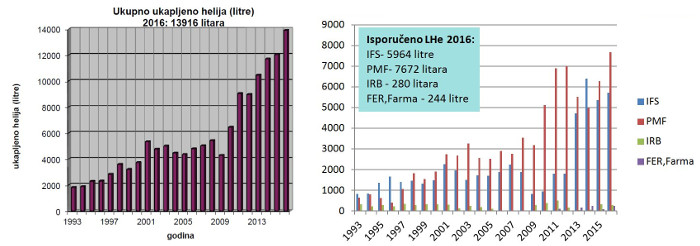This website uses cookies to ensure a better user experience.
To get more information, please read our Cookie Statement.
Cryogenic Facility
Quantities of delivered liquid helium (litres) per year
One observes continuously rising liquid helium spending over the years. Several years stagnant in the delivered litres (2003-2008) is a consequence of ‘technological bottlenecks’ the as-delivered plant. Infrastructural investment of approx. 1,000.000 Kn in 2007-2008 enables the plant upgrade and significant rise in liquefaction capacity.
Why cryogenics?
Modern research canter involved in research of broad spectrum of natural and material sciences, from fundamental physics to pharmaceutics, cannot be conceived without the cryogenic range of temperatures, either for research of phenomena and properties of matter at low temperatures and/or for generation of high and homogenous magnetic fields by the use of superconducting coils. In spite of recent rapid spreading of cryogen-free technology liquid helium remains, from plenty of reasons, fundamental resource of low-temperature research, especially for those institutions being already privileged by previously built-in helium liquefier plants. Location of such plant inside or in immediate vicinity of research centre is conditioned by number of practical and financial arguments. Liquid helium plant represents today an unavoidable infrastructural element of any larger research centre, especially of those seriously involved in condensed matter physics. Availability (or non-availability!) of the system for helium liquefaction//recycling) thus represents remark of the scientific and technological competence of the particular Centre and of the social environment it is integrated inside.

For users spending thousands of liquid helium per year (like Institute of Physics and Department of Physics of Zagreb’s Faculty of Natural Sciences) helium liquefaction/recycling is demanded particularly form the financial point of view. On long term, helium recycling is important from the ecological standpoint as well – helium on Earth is, like fossil fuels, a non-recoverable geological resource. Traces of helium in atmosphere are considered, by present economy standards, to expensive for commercial extraction.
Cryogenic facility of Institute of Physics
Cryogenic facility of Institute of Physics represents the central point for liquid helium supply for numerous research projects and laboratories at Institute of Physics and neighbouring institutions, and Department of Physics of Zagreb’s Faculty of Natural Sciences and Institute Ruđer Bošković. Simultaneously, the plant supplies liquid helium to other laboratories located in Zagreb like those at Faculty of Pharmacy and Biochemistry and Croatian Metrology Institute.
A little bit of history…
At Institute of Physics helium is being liquefied in continuity since the end of 1967, following the installation of helium liquefier manufactured by AD Little, Inc. USA. The machine is known under the name Collins liquefier in honour of its MIT-designer Samuel C. Collins. The main credit for research orientation to low temperature physics and cryogenics belongs to Institute of Physics’ founder, academician Mladen Paić.
After 25 years of service the Collins machine was replaced, in early 90-ties, by a new liquefier manufactured by Koch Process Systems, Inc.-USA, featuring four-fold bigger liquefaction capacity (20 litters/hour with LN2 precooling).

First liquefaction of helium at Institute of Physics, end of 1967.
In the figure (from right to left): academician Ksenofont Ilakaovac, technician Vlado Malnar, academician Mladen Paić, dr. Rudolf Krsnik and the company’s service engineer (name unknown).
 The last liquefaction in 1989 using Collins liquefier.
The last liquefaction in 1989 using Collins liquefier.
In the figure: academician Mladen Paić with his wife dr. Valerija Paić, prof.dr Boran Leontić, prof.dr Emil Babić prof.dr. Amir Hamzić, tehnician Mile Sertić, dr. Đuro Drobac, dr. Marko Miljak, dr.Mladen Prester, dr. Zlatko Vučić, dr. Jagoda Lukatela, dr. Katica Biljaković and dr. Ana Smontara.
Present-day helium liquefaction plant at Institute of Physics
Main system: M1410 Koch Process Systems, Inc.-USA
ing. Josip Pogačić
ing. Žarko Vidović
Plant leader from research staff:: dr.sc. Mladen Prester (prester@ifs.hr)

Left: ‘Cold Box’ of the present-day helium liquefier M1410 (Koch Process systems, Inc.-USA).
Right: Two 1410 helium compressors, 50 kW total power, featuring water cooling.
The plant represents a rather complex system of the functionally coupled devices: central M1410 unit with two helium compressors, achieving liquefaction of 20 litre/hour or 10 litres/hour with or without LN2 precooling, respectively. Liquefier integrates a built-in helium purifier while there also belong to the plans a cryo-adsorber, stationary 280 litres dewar, big recovery compressor with recycling balloons, system of recovery lines permeating the whole Institute, helium purity analyser, water tower with automatic cooling- water regulation and the number of He bottle batteries for gaseous helium storage.
Liquid helium delivery over the years
The present-day users are the following laboratories from several institutes:
Laboratory users form IF:
- Strongly correlated electronic systems laboratory (dr. sc. Ivica Aviani)
- Laboratory for physics of transport properties (dr.sc. Ana Smontara)
- Complex systems laboratory (dr. sc. Katica Biljaković)
- Laboratory for solid state dielectric spectroscopy studies (dr. sc. Silvia Tomić)
- Magnetotrasnport measurement laboratory (dr.sc. Bojana Hamzić)
- Laboratory for static magnetic properties (dr. sc. Mirta Herak)
- AC susceptibility laboratory (dr. sc. Mladen Prester)
Laboratory users from Department of Physics:
- Laboratory for low temperatures and strong magnetic fields (prof.dr. Amir Hamzić)
- Laboratory for solid state NMR and high-frequency measurements (prof.dr. Miroslav Požek)
- Laboratory for synthesis and measurements of transport, magnetic and thermodynamic properties (prof.dr. Ivan Kokanović)
- Laboratory for research of electric and magnetic phenomena (prof.dr. Krešo Zadro)
Laboratory user from Ruđer Bošković Institute:
- Magnetic resonances laboratory (dr.sc. Marina Ilakovac Kveder)
Laboratory user from Croatian Metrology Institute:
- Primary electromagnetic laboratory (Prof.dr. Damir Ilić)
Laboratory user from Faculty of Pharmacy and Biochemistry:
- Department for Organic Chemistry (Prof.dr. Valerije Vrček)





